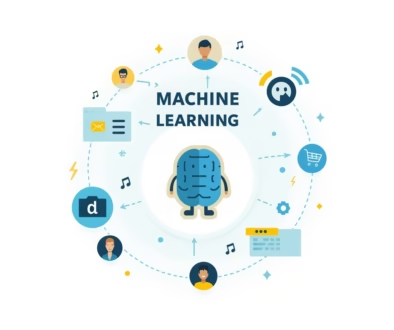AI Side Hustles in 2025: 7 Profitable Ways to Earn Using AI Tools
My friend Sarah texted me at 4 PM last Tuesday. “Holy crap,” she wrote. “I just made $2,847 this month helping restaurants with their Instagram posts. Using ChatGPT. I can’t believe this is working.”
Thank you for reading this post, don't forget to subscribe!
Sarah’s a yoga instructor, not some tech wizard. Six months ago, she didn’t even know what “prompt engineering” meant. But she saw an opportunity and grabbed it with both hands.
And honestly? She’s just getting started.
Look, I get it. Everyone’s talking about AI these days, and half the time it sounds like science fiction. But here’s the thing nobody’s telling you: while everyone else is arguing about whether robots will take our jobs, smart people are already using AI to create new ones.
The gold rush isn’t coming. It’s here. Right now.
Why This Moment Won’t Last Forever
Remember when your uncle started selling stuff on eBay in 1999 and everyone thought he was nuts? Then Amazon came along, and suddenly everyone wished they’d started an online business back when it was easier.
That’s where we are with AI right now.
Most small businesses know they need AI help, but they’re completely lost. They’ve heard the buzzwords, watched a few YouTube videos, and… that’s it. They’re stuck. Overwhelmed. Willing to pay good money to someone who can just make it simple for them.
But this window won’t stay open forever. Eventually, AI tools will get so simple that my grandmother could use them (she still calls me to help reset her router, by the way).
The question is: are you going to jump in now, or wait until everyone else figures it out?
7 Ways I’ve Seen Regular People Make Real Money with AI
According to Forbes, some AI-powered solo ventures—like AI consulting, content reviewing, and marketing consulting—are already raking in up to $100,000 per year. That’s not just hype—it’s real success happening right now as people learn to pair real-world knowledge with AI tools to create high-value, high-paying services.
1. Become the Content Person Every Business Needs
Here’s what happened to Marcus in Austin. Guy was making maybe $40K as a freelance copywriter, struggling to compete with cheaper writers on Upwork. Then he had a lightbulb moment.
Instead of fighting AI, he partnered with it.
Now he calls himself an “AI-Enhanced Content Strategist” (fancy, right?). He uses ChatGPT to research topics and generate first drafts, then adds his own expertise and personality. The result? Content that’s faster to produce but still sounds human.
His income jumped from $3,000 to $8,500 per month in six months.
What you need to get started:
- ChatGPT subscription ($20/month)
- Grammarly for polishing ($12/month)
- Canva for visuals ($15/month)
- A niche you actually understand
The reality check: You’re not just pushing buttons and collecting checks. You still need to understand good writing, know your client’s voice, and add strategic thinking. AI handles the heavy lifting; you handle the brain work.
What you could earn: Most people I know doing this well make $2K-$6K monthly part-time. Full-time? Sky’s the limit.
Getting your first client: Pick three local businesses you actually shop at. Study their current content. Then email them a specific idea for improving their Instagram or blog, with a sample post you created. Don’t pitch services—show results first.
2. Build Simple Chatbots (No Coding Required)
Jessica owns a small marketing consultancy in Phoenix. Last year, she noticed all her restaurant clients asking the same question: “How do I stop answering the same customer questions over and over?”
So she learned Chatfuel over a weekend.
Her first bot was for Tony’s Pizza downtown. Simple ordering system, FAQ responses, store hours. Cost her maybe 10 hours to build. She charged $800 upfront plus $150/month maintenance.
That bot increased Tony’s online orders by 35% in the first month.
Word spread fast. Now Jessica manages chatbots for 12 local businesses and makes more from bots than from her original consulting work.
Tools that actually work:
- Chatfuel or ManyChat (start free)
- Zapier for connecting things ($20/month)
- Your brain (most important part)
The secret sauce: Don’t build complicated bots. Build ones that solve one specific problem really well. Restaurant ordering. Appointment booking. Basic customer questions. That’s it.
Realistic timeline: You can build your first functional bot in a weekend if you focus. Getting good enough to charge premium prices? Maybe 2-3 months of practice.
What clients actually pay: $500-$2,500 per bot build, $100-$500/month for maintenance and updates.
3. Become a Research Machine
David stumbled into this one by accident. He was helping a friend research competitors for a new business idea, using ChatGPT to analyze industry trends and compile data. What should have taken weeks took him maybe 6 hours.
His friend was blown away and paid him $500 for the report.
That’s when David realized something: everybody needs research, but nobody wants to do it.
Now he creates “AI-Powered Market Intelligence Reports” for startups, consultants, and small businesses. Each report takes him 4-8 hours but sells for $500-$1,500.
His basic process:
- Use Perplexity AI to gather industry data
- ChatGPT to analyze trends and synthesize insights
- Create a professional-looking report with actionable recommendations
- Deliver insights that would normally cost $5K+ from a consulting firm
Tools you’ll need:
- Perplexity Pro ($20/month) – this is the secret weapon
- ChatGPT for analysis ($20/month)
- Basic design skills (Canva works fine)
- Understanding of business fundamentals
Getting started: Pick an industry you know something about. Create a sample report on a trending topic. Share key insights on LinkedIn. Watch the inquiries roll in.
What people pay: $500-$1,500 per report. David does 8-10 per month working maybe 15 hours per week on this.
4. Create Online Courses (With AI As Your Assistant)
Maria always wanted to teach her Pinterest marketing system but felt overwhelmed by course creation. Writing scripts, creating workbooks, planning modules—it seemed impossible.
Then she discovered AI could be her course creation assistant.
She used ChatGPT to help outline her course, write video scripts, and create student exercises. Instead of taking 6 months, she launched in 6 weeks.
Her Pinterest course has generated over $15,000 in sales so far, and she’s working on two more.
How AI helps with courses:
- Generates detailed course outlines
- Writes video scripts in your voice
- Creates quizzes and exercises
- Helps with marketing copy
- Suggests bonus materials
What you still need to do:
- Actually know something worth teaching
- Record engaging videos
- Build an audience (this part hasn’t changed)
- Handle student questions and support
Tools that matter:
- ChatGPT for content creation ($20/month)
- Loom for screen recording (free tier works)
- Teachable or similar platform ($39-$119/month)
- ConvertKit for email marketing ($29+/month)
The hard truth: Creating the course is the easy part. Marketing and selling it requires real work and strategy.
5. Social Media Management on Steroids
Tom was already managing social media for a few local businesses, making decent money but working crazy hours. Creating content, scheduling posts, engaging with comments—it was burning him out.
AI changed everything.
Now he uses ChatGPT to generate content ideas and write posts, Midjourney for custom graphics, and scheduling tools to batch everything. He went from managing 3 accounts to 8, while actually working fewer hours.
His secret? He doesn’t just post random content. He creates strategic content calendars that tell a story and drive business results.
Monthly routine:
- Spend 2 hours planning content themes and campaigns
- Use AI to generate 30 days of post ideas
- Batch create all graphics and copy
- Schedule everything
- Monitor and engage daily (30 mins max)
Tools in his stack:
- ChatGPT for content ideas ($20/month)
- Midjourney or Canva for visuals ($10-15/month)
- Buffer for scheduling ($5-$50/month depending on accounts)
- Analytics tools to track what works
Client pricing: $600-$1,200 per month per client, depending on posting frequency and complexity.
Getting clients: Start with businesses you already support. Offer to audit their current social media for free. Show them exactly what you’d do differently.
6. Build Micro-SaaS Tools (Easier Than You Think)
Alex was a real estate agent who got tired of writing property descriptions. Same boring template, over and over.
So he built a simple tool that uses AI to write better property descriptions. It took him three weeks using Bubble (a no-code platform) and the OpenAI API.
The tool costs $29/month, and he has 43 paying subscribers. That’s $1,247 monthly recurring revenue for something he built as a side project.
Why micro-SaaS works:
- Solve one specific problem really well
- No-code tools make building easier than ever
- AI APIs add smart features without complex programming
- Small markets can still be profitable
His tech stack:
- Bubble for the interface (no coding required)
- OpenAI API for the AI functionality
- Stripe for payments
- Simple landing page
Finding ideas: Look for repetitive tasks in industries you understand. What takes people 30 minutes that could take 30 seconds with the right tool?
Reality check: Building is just the beginning. You still need to find customers, handle support, and iterate based on feedback. But if you solve a real problem, people will pay.
7. Teach People What You’re Learning
Rachel started documenting her AI experiments on LinkedIn six months ago. Just sharing what worked, what didn’t, and what she learned.
Those posts started getting attention. Business owners commenting, asking questions, wanting to know more.
Now she runs “AI Implementation Workshops” for small marketing agencies. Two-day intensives where she teaches teams how to integrate AI into their workflows.
She charges $2,000 per workshop and books 3-4 per month.
What she teaches:
- Which AI tools actually work (vs. just hype)
- How to write effective prompts
- Workflow integration strategies
- Team training and adoption
- Real case studies and examples
Her content strategy:
- Share one AI experiment per week on LinkedIn
- Always include specific results (what worked, what didn’t)
- Answer every comment and question
- Build relationships, not just followers
Workshop structure:
- Morning: Tool demonstrations and hands-on practice
- Afternoon: Custom workflow development for their business
- Follow-up: 30 days of email support
Getting started: You don’t need to be an expert. You just need to be a few steps ahead of your audience and willing to share what you learn.
Which One Should You Pick?
Look, I could give you some generic advice about “following your passion.” But let’s be practical.
If you’re already a decent writer: Start with content creation services. You’ve got the foundation; AI just makes you faster.
If you understand business processes: Chatbots or research services. You can see problems AI can solve.
If you’re good with people: Training and consultation. Your ability to explain and teach is the real value.
If you want passive income: Course creation or micro-SaaS. Higher upfront effort, but potential for ongoing revenue.
If you want fast cash: Content creation and social media management have the shortest sales cycles.
If you want to build something big: Micro-SaaS has the highest ceiling, but also the highest failure rate.
Your Week One Game Plan
Forget elaborate business plans. Here’s what you’re doing this week:
Monday-Tuesday: Pick ONE side hustle from this list. Just one. Don’t get fancy.
Wednesday-Thursday: Sign up for the tools and spend time learning them. Most have free trials—use them.
Friday-Saturday: Create your first sample. Content piece, bot demo, research report, whatever fits your chosen path.
Sunday: Share your work. Social media, email to potential clients, relevant online communities. Get it out there.
That’s it. No overthinking. No perfect plans. Just action.
The Tools You Actually Need (And What They Cost)
For Content Creation:
- ChatGPT Plus: $20/month
- Grammarly Premium: $12/month
- Canva Pro: $15/month
- Total: $47/month
For Chatbots:
- Chatfuel: Free to start, $15/month for features
- Zapier: $20/month
- Total: $35/month
For Research Services:
- Perplexity Pro: $20/month
- ChatGPT Plus: $20/month
- Canva Pro: $15/month
- Total: $55/month
For Online Courses:
- ChatGPT Plus: $20/month
- Teachable: $39/month
- Loom Pro: $8/month
- ConvertKit: $29/month
- Total: $96/month
For Social Media Management:
- ChatGPT Plus: $20/month
- Canva Pro: $15/month
- Buffer: $5/month
- Total: $40/month
Most of these have free tiers or trials. Start there, upgrade when you’re making money.
The Mistakes That Kill Most People
Mistake #1: Trying to do everything at once. Pick one side hustle. Master it. Then expand if you want.
Mistake #2: Undercharging because “it’s just AI.” You’re not selling button-pushing. You’re selling results, expertise, and time savings. Price accordingly.
Mistake #3: Thinking AI does everything. It doesn’t. AI handles the grunt work. You handle strategy, creativity, and client relationships.
Mistake #4: Waiting for perfect. Your first bot will suck. Your first course will have flaws. Launch anyway. Improve as you go.
Mistake #5: Forgetting to market. The best AI workflow won’t make you money if nobody knows about it.
The Truth Nobody Talks About
Here’s what the other blog posts won’t tell you: most people who try this will quit within 3 months.
Not because it doesn’t work, but because they expect magic.
AI makes certain tasks easier and faster. It doesn’t eliminate the need for hard work, learning, and persistence. You still need to:
- Understand your clients’ real problems
- Deliver consistent quality
- Handle difficult conversations
- Manage your time and finances
- Keep learning as tools evolve
The people making serious money aren’t the ones with the fanciest prompts or latest tools. They’re the ones who solve real problems for real people and do it consistently.
What Happens Next
The AI opportunity window is wide open right now, but it won’t stay that way forever.
In 12 months, some of these side hustles might be harder to start (more competition). Others might be even more profitable (growing market).
Nobody knows for sure.
What I do know is this: the people making money a year from now will be the ones who started this month.
So pick your side hustle. Get your tools. Create your first sample. Find your first client.
Stop planning and start doing.
The AI gold rush is happening right now. Your only choice is whether to grab a shovel or watch from the sidelines.
I’m tracking exactly how people are building these AI side hustles—the tools they use, the mistakes they make, the breakthroughs they have. Want to follow along? Hit me up in the comments with which opportunity interests you most, and I’ll keep you posted on what’s working.
FAQ: The Questions Everyone Asks
Q: Do I really need to be technical to make this work?
Not even close. I know yoga instructors and restaurant managers doing this stuff. If you can use Instagram and send emails, you can handle these tools. The technical barrier is mostly in your head.
Q: How much money are we really talking about here?
Depends entirely on you. I’ve seen people make their first $500 in two weeks, and others take three months to land their first client. Most people doing this consistently make $1,500-$4,000 monthly within six months. The ceiling? I know folks clearing $15K+ per month, but they’re treating this like a real business.
Q: What if the AI tools change or get more expensive?
They will. That’s why you don’t build a business around one specific tool—you build it around solving problems. The tools are just how you solve them. When better tools come out, you adapt.
Q: Is this just a fad that’ll disappear?
Every major technology creates opportunities like this. The internet, smartphones, social media—they all had “gold rush” phases where early adopters made bank. AI is following the same pattern, just moving faster. The specific opportunities might evolve, but the underlying trend is solid.
Q: What if I start this and hate it?
Then you stop. You’re not signing a 30-year mortgage here. Worst case, you spend $50-$100 on tools and a few weeks learning something new. Best case, you build a profitable side business. The risk-reward ratio is pretty favorable.



